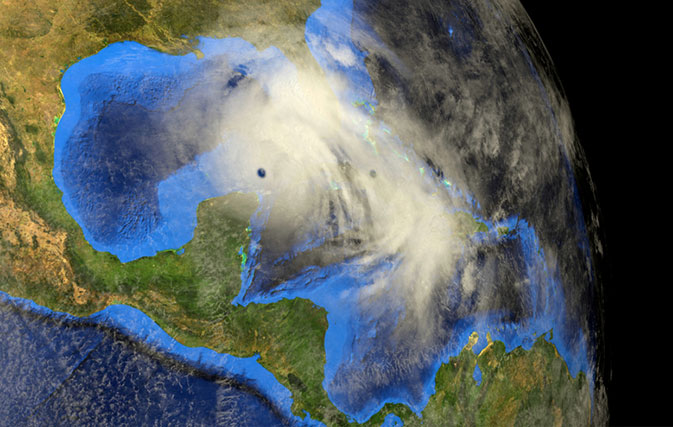NEW ORLEANS — Tropical Storm Marco was falling apart Monday but setting a messy stage for the arrival of Laura as a potentially supercharged Category 3 hurricane along the U.S. Gulf Coast.
Tropical Storm Laura was just south of Cuba and not expected to weaken over land on Monday before moving into “very warm and deep” southeastern Gulf waters. Forecasters raised the ominous possibility that this “could trigger a brief period of rapid intensification,” potentially reaching winds of more than 177 kph.
“There is definitely a possibility that it could be a little bit stronger and be a Category 3,” said meteorologist Benjamin Schott, who runs the National Weather Service office in Slidell, Louisiana.
The two-storm combination could bring a history-making onslaught of life-threatening winds and flooding along the coast, stretching from Texas to Alabama, forecasters said.
“What we know is there’s going to be storm surge from Marco, we know that that water is not going to recede hardly at all before Laura hits, and so we’ve not seen this before and that’s why people need to be paying particular attention,” Gov. John Bel Edwards warned at a Sunday briefing.
State emergencies were declared in Louisiana and Mississippi, and shelters were being opened with cots set farther apart, among other measures officials hoped will curb coronavirus infections.
“The virus is not concerned that we have hurricanes coming, and so it’s not going to take any time off and neither can we,” Edwards said.
Louisiana and Mississippi evacuees can’t forget the damage caused by Hurricane Katrina in 2005, when catastrophic flooding breached the levees in New Orleans and as many as 1,800 people died.
August Creppel, Chief of the United Houma Nation, was concerned about the group’s 17,000 members, spread out over six parishes along the Louisiana Gulf Coast. He’s already been in contact with the Red Cross to get supplies once the weather eases.
“I’m very concerned for my people,” he said. “We know our people are going to get hit. We just don’t know who yet.”
The double punch comes just days before Katrina’s August 29 anniversary. Creppel took part in a ceremony Saturday at the Superdome in New Orleans that included Native American singing and prayers to commemorate the hurricane’s 15th anniversary.
Marco’s top winds dropped to 80 kph and was centred about 135 kilometres south-southeast of the mouth of the Mississippi River and heading northwest at 17 kph Monday morning. Forecasters expected it to remain just offshore Tuesday as it weakens and dissipates, leaving a flooded coastline ahead of Laura’s surge.
Laura’s centre, meanwhile, was skirting Cuba’s southern coast on Monday after causing the deaths of at least 11 people in the D.R. and Haiti, knocking out power and causing flooding in the two nations that share the island of Hispaniola.
Laura’s top sustained winds were 100 kmh on Monday morning, but one computer model showed Laura can gain more than 100 kph to its wind speed over the next 48 hours, which is 4.8 times more than average for that time period, University of Miami hurricane researcher Brian McNoldy said Monday.
Marco not only weakened overnight losing hurricane status because of decapitating high level winds, its centre is so messy and torn apart that most of the storm’s fury is to its northeast, along the Florida panhandle, University of Miami hurricane researcher Brian McNoldy said Monday.
“It does look to be a bit of a mess right now,” McNoldy said.
For the residents of the Louisiana coast, “they’re certainly lucky that Marco is not worse than it is,” McNoldy said. “This will come and go and they can get ready for Laura. That’ll be the main attraction.”
Just as the small-in-size disorganized Marco is being torn apart by wind shear, the larger more classic Laura is about to head into the bathtub -warm waters that are a hurricane’s feeding grounds. And the winds that are hampering Marco won’t be a factor, McNoldy said.
Rain bands from both storms could bring a combined total of 2 feet (0.6 metres) of rain to parts of Louisiana, potentially raising the storm surge to more than 10 feet along the Louisiana coast line and pushing water 48 kilometres up the rivers in a worst-case scenario, Schott said.
SOURCE: The Associated Press
